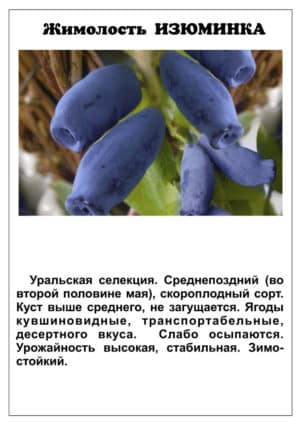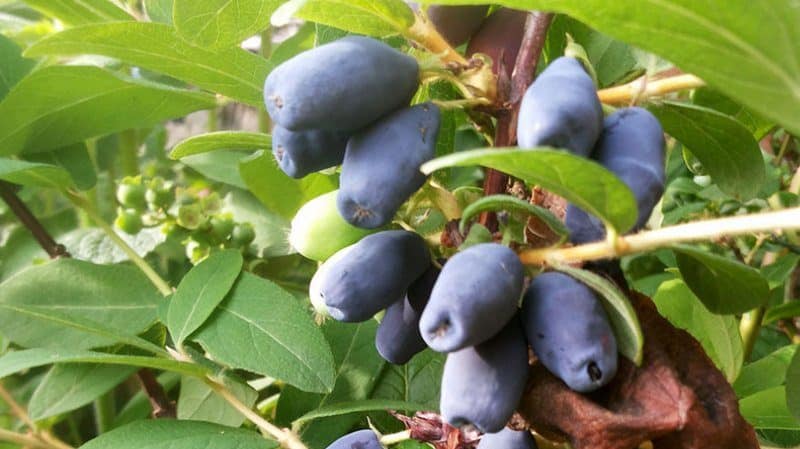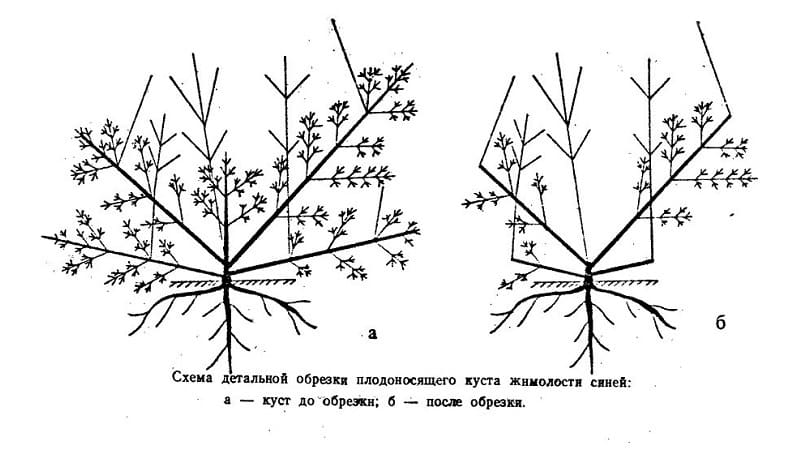Consistently productive honeysuckle variety “Izyuminka” from Russian breeders
The highlight is a variety of edible honeysuckle, bred by Russian breeders, with high productivity, unpretentiousness and resistance to low temperatures. In the article we will talk in detail about the features of this variety, methods of propagating bushes and the requirements that Izyuminka makes for planting and care.
What kind of honeysuckle is this?

The highlight is a mid-season honeysuckle variety. Characterized by slow growth during the first 3-4 years. Fruiting begins 3-4 years after planting. The average yield is 27 c/ha or 0.9-1.4 kg per bush.
The harvest is harvested when the berries reach full color. The fruits are stored in the refrigerator for no more than three days.
Brief history of origin and distribution
The variety was obtained by breeders V. S. Ilyin and N. A. Ilyina at the South Ural Research Institute of Horticulture and Potato Growing as a result of free pollination of Kamchatka honeysuckle.
Included in the state register of Russia in 1999 with permission for cultivation in all regions.
Characteristics and description of bushes

The bushes are medium-sized - 1.2-1.3 m in height, slightly spreading with a compact crown of an obverse conical shape and thin curved shoots of brown color with a violet-lilac tint, pubescent.
The leaf blades are slightly fleecy, broadly lanceolate, medium in size, concave in shape with a pointed and curled apex, light green in color.
During the flowering period, pale, bell-shaped, medium-sized flowers appear on the bushes.
Temperature resistance
The bushes tolerate drops in air temperature down to -50°C with virtually no loss, and can withstand frosts down to -8°C during flowering.
Reference. With prolonged winter warming, the bushes may open fruit buds, which will die due to returning frosts.
Moisture and drought resistance
With high humidity caused by excessive watering or close proximity to groundwater, the risk of root rot increases. At the same time, lack of moisture and prolonged drought negatively affect the yield and taste of berries.
Resistance to diseases and pests
The raisin is immune to viral diseases, but under unfavorable climatic conditions and improper care it can be affected by powdery mildew and various types of spotting.
Among the pests that can attack the bushes are honeysuckle, aphids, scale insects, and leaf rollers.
This is interesting:
Frost-resistant early ripening honeysuckle variety “Lakomka”.
Characteristics and description of fruits

The berries are elongated oval in shape, large, reach 1.8-2.7 cm in length and weigh on average 1.1-1.6 g, with a lumpy surface, covered with a dense, but not hard, bluish-blue skin with an intense layer bluish waxy coating.
The fruits contain 13.9% dry matter, 7.4-8.9% sugar, 2.1-2.2% acid, 31-48 mg vitamin C, 950 mg vitamin P (P-active compounds).
The pulp is fibrous, aromatic, has a pleasant sweet and sour taste with spicy notes, without bitterness.
Areas of their application
Raisin berries are consumed fresh, frozen, or dried. The fruits are also suitable for various types of processing, including the preparation of juices, preserves, jams or marmalade.
Due to the decorative appearance of the bushes, especially during flowering, they are often used to decorate parks, squares and gardens.
Advantages and disadvantages of the variety

Main advantages:
- stable fruiting;
- large fruit;
- there is no tendency for berries to fall off;
- frost resistance;
- immunity to viral diseases;
- decorative appearance of bushes;
- excellent taste of fruits;
- ease of care.
The disadvantages of Izyuminka honeysuckle include relatively low yield and the need for replanting with pollinating varieties.
Growing technology
For good fruiting, honeysuckle bushes are provided with comfortable conditions: they choose a place suitable for planting, plant them at the optimal time and properly care for the plants.
Optimal conditions
To plant honeysuckle, choose a bright, unshaded place, protected from gusty winds. The permissible level of groundwater is 50 cm. The variety develops and bears fruit best on fertile, loose soil with good aeration, moisture permeability and weak acidity. The best option is sandy loam and loam.
When choosing seedlings, preference is given to two-year-old specimens with 2-4 elastic shoots 30-40 cm long and a branched root system.
Landing dates and rules
Due to the early growing season in spring, honeysuckle is planted on the site in the fall: at the end of September or beginning of October.
Reference. Spring planting is permissible as soon as the soil thaws and before the buds wake up.
Landing rules:
- Dig holes measuring 40x40x40 cm in the prepared area.
- Fill each two-thirds with a nutrient mixture (half of the excavated soil, two buckets of humus or compost, 200 g of double superphosphate and potassium salt).
- Form a hill at the bottom of the hole, place a seedling on top, and spread its roots along the slopes.
- Fill the hole with soil, compact it - the root collar is buried 3-4 cm.
- Water the bushes, pouring 10 liters of water under each bush.
- Mulch the ground in the tree trunk circle with a 4 cm layer of sawdust, dry straw or humus.
Further care
The bushes are watered on average once a week or 10 days, focusing on the condition of the soil: it should not dry out, but waterlogging is also unacceptable.
The day after watering or rain, the soil is loosened to improve the access of moisture and oxygen to the roots of plants, and weeded, getting rid of weeds.
Fertilizing begins in the third year after planting the seedlings according to the following scheme:
- from early spring to mid-summer, every two weeks - a solution of ammonium nitrate (30 g per 10 liters of water) at the rate of 1-1.5 liters per bush, mullein or bird droppings;
- after picking the berries - a solution of nitroammophoska (25-30 g per bucket of water) or slurry;
- autumn - 5 kg of compost, 100 g of ash and 40 g of double superphosphate per 1 sq. m.
When the plants become too dense, cut out a few shoots growing from the ground and dry, old, damaged and short branches. In the spring, sanitary pruning is carried out, getting rid of the tips of shoots damaged by frost and disease.
For bushes older than 6-7 years, anti-aging pruning is carried out, completely cutting off the shoots and leaving 40-50 cm stumps or removing 2-3 old branches, leaving the same number of young ones.
Possible problems, diseases, pests
Diseases and pests that, under unfavorable conditions, can affect Zest:
| Disease, pest | Signs | Treatment, prevention |
| Powdery mildew | The leaf blades are covered with a white powdery coating. | In early spring, plants are treated with a solution of copper sulfate, Fundazol or Topaz. |
| Various types of spotting | Spots of various colors, colors and shapes appear on the leaf blades. | |
| Honeysuckle fingerwing | Pests eat the seeds and pulp of the berries. Fruits that are not fully ripened darken, wrinkle, and crumble. | After harvesting, the bushes are treated with preparations such as Karbofos or Chlorophos. Among the special preparations, choose “Decis”, “Eleksar” or “Inta-Vir” in case of attack by leaf-eating pests, and “Aktellik”, “Confidor”, “Rogor-S” if the bushes are attacked by sucking insects. |
| Honeysuckle aphid | Insects feed on the sap of the leaves, they dry and wither. | |
| Shields | The bushes dry out and slowly die. | |
| Leafrollers | In the caterpillar stage, insects roll up the leaves of plants, entwine them with cobwebs and settle inside. The foliage is dying. |
Wintering
Preparing honeysuckle for winter involves removing all fallen leaves, pruning bushes if necessary, clearing the trunk circle of used organic mulch and covering it with a new layer of mulch.
Reproduction
Raisin bushes are propagated vegetatively: by cuttings, layering or dividing the bush.
Reference. When propagated by seed, the plant loses its varietal characteristics.
Cuttings are harvested in early spring, before the buds open. Select strong annual shoots with a diameter of at least 7-8 mm and cut them into pieces 7-12 cm long so that each has 2-3 buds. The cuttings are soaked for a day in a solution of a growth stimulator (Kornevin, Heteroauxin), after which they are planted in a container with a peat-sand substrate and covered with film. Plants take root after 30-35 days.
To propagate by layering in the spring, select a horizontal, low-lying shoot on the bush, lightly cut the bark on it, bend it to the ground, fix it, sprinkle it with soil and water it. When the shoot takes root, it is separated from the mother bush and planted in a permanent place.
Plants older than 6 years are propagated by division. In early spring or late autumn, the bush is dug up and, using a sharp sterile instrument, divided into several parts, which are planted on the prepared area and watered.
Advice. When dividing the bush, the shoots are cut by a third.
Features of growing this variety, depending on the region

Honeysuckle Zest has standard requirements for planting and growing, regardless of the climate of the region.
Pollinator varieties
The highlight is a self-sterile honeysuckle variety. In order for the bushes to set fruit and produce a harvest, suitable pollinating varieties are planted nearby:
- Zarnitsa;
- Goryanka;
- Atlant;
- Viola;
- Enchantress;
- Altair.
Reviews from summer residents
Gardeners who tried to grow Izyuminka liked the variety.
Valeria, Omsk: “We planted several varieties of honeysuckle, including Izyuminka, four years ago. I liked the taste of the berries of this particular variety - they are sweet, with sourness, and at the same time one can feel the tartness. The harvest is still small, but this is not the main thing - we planted the bushes primarily to create a hedge. In addition, we read that yields increase over time.”
Julia, Saratov: “At the dacha, Izyuminka has been growing for a long time. We didn’t really take care of the bushes, we only trimmed them from time to time, because the bushes were becoming very dense. The berries are incredibly tasty, but there are not so many of them. Although it’s enough for our family. We mostly eat them fresh and freeze some for the winter.I haven’t tried making jam, but my neighbor does it and it turns out delicious.”
Read also:
Frost-resistant early ripening honeysuckle variety “Lakomka”
Conclusion
The highlight is a fast-growing, unpretentious variety of honeysuckle, characterized by high immunity to many diseases and a pleasant sour-sweet taste of the berries. Due to its high degree of frost resistance, Izyuminka is successfully cultivated in all regions.